-
Paper Information
- Paper Submission
-
Journal Information
- About This Journal
- Editorial Board
- Current Issue
- Archive
- Author Guidelines
- Contact Us
International Journal of Internet of Things
2016; 5(1): 1-8
doi:10.5923/j.ijit.20160501.01

A Method of Prototype Construction for the Active Creation of IoT Application Ideas and Its Evaluations
Nobuhiro Ohe1, Masahito Ishihara2, Hironobu Yonemori3, Shinji Kitagami4, Masahiro Inoue5, Jun Sawamoto6, Tetsuo Shiotsuki7
1Melco Techno Yokohama Co. Ltd., Kanagawa, Japan
2Faculty of Childhood Education, Hosen College of Childhood Education, Tokyo, Japan
3Department of Mechanical and Electronic Engineering, Salesian Polytechnic, Tokyo, Japan
4Mitsubishi Electric Building Techno-Service Co. Ltd., Tokyo, Japan
5Department of Electronic Information Systems, Shibaura Institute of Technology, Saitama, Japan
6Department of Software and Information Science, Iwate Prefectural University, Iwate, Japan
7Department of Robotics and Mechatronics, Tokyo Denki University, Tokyo, Japan
Correspondence to: Nobuhiro Ohe, Melco Techno Yokohama Co. Ltd., Kanagawa, Japan.
| Email: |  |
Copyright © 2016 Scientific & Academic Publishing. All Rights Reserved.
This work is licensed under the Creative Commons Attribution International License (CC BY).
http://creativecommons.org/licenses/by/4.0/

In recent years, various applications are expected to arise for IoT systems that incorporate sensor technology, network technology, and information processing technology. With IoT systems, several technologies must be combined systematically. Design and construction of IoT systems require great amounts of knowledge, time, and funds. In this paper, we propose a method of prototype construction for the active creation of IoT application ideas. This method clearly presents contents and procedures for prototyping for students of non-IT courses and non-science/non-engineering courses in their own specialized fields. This method has an IoT device implementation framework. Application of the framework facilitates ease of connection of versatile sensors and actuators. After the prototype is constructed according to this construction method, those who constructed it (constructors) can perform problem solving, idea creation, and needs assessment related to their own specialized fields. This construction method was applied practically by science and engineering students in non-IT courses and non-science/non-engineering students, for whom its effects were evaluated.
Keywords: IoT system, M2M system, Prototype, Gateway, Cloud, Sensor, Actuator
Cite this paper: Nobuhiro Ohe, Masahito Ishihara, Hironobu Yonemori, Shinji Kitagami, Masahiro Inoue, Jun Sawamoto, Tetsuo Shiotsuki, A Method of Prototype Construction for the Active Creation of IoT Application Ideas and Its Evaluations, International Journal of Internet of Things, Vol. 5 No. 1, 2016, pp. 1-8. doi: 10.5923/j.ijit.20160501.01.
Article Outline
1. Introduction
- Internet of Things (IoT) and Machine to Machine (M2M) systems can perform automatic processing using various sensors, networks, and information processing technologies, fused together in a cross-sectional manner. Actually, IoT/M2M systems are applicable to fields of industry, public infrastructure, and medical care and welfare, and to life areas of human society. In many fields, IoT technology has been applied extensively [1-5]. This rapid extension of applications is attributable to rapid advances in sensor technology for detecting the status of object devices and network technology for collecting data from many locations. Moreover, cloud computing has evolved quickly.Future IoT/M2M systems are expected to extend the range of applications further. For that to occur, both idea creation for practical applications and human resource development are crucially important. However much knowledge must be acquired to design and construct IoT systems, frequently entailing longer time periods and higher costs. If prototype construction methods using open hardware and software were available, then the constructor could produce IoT prototype systems rapidly. They could understand IoT systems through prototyping. Using IoT prototyping, a constructor could solve problems of their own fields and create ideas to meet specific needs.In this paper, we propose a method of prototype construction for the active creation of IoT application ideas. The method includes basic configuration of the IoT prototype and procedure. Basic configuration elements are selected from open hardware and software. Then the prototype constructor can produce an IoT system prototype from this basic configuration. The contents of prototyping and procedures of construction are defined by every specialized field. Particularly, sensors and actuators of numerous types are involved in the construction. The proposed construction method has an implementation framework of the IoT device to enable ease of handling of these elements. A prototype system was constructed according to the construction method and implementation framework. Based on the prototype construction experience, the constructor can expand the prototype, create ideas, and ascertain needs for problem-solving of their own specialized field.The construction method proposed herein was applied to the education of science and engineering students of non-IT course and non-science/non-engineering course students. Then its features and efficacy were evaluated.
2. Outline of IoT and Prototyping
- (1) Outline of IoT systemAttention has been given recently to IoT systems using sensors and equipment connected to the internet to provide diverse services without human intervention [1-4]. Results of these studies have clarified the IoT system architecture. Figure 1 presents an IoT system outline. The figure shows sensors and actuators of various types mounted on the device shown at the left. Data from the device are transmitted to the server or cloud via the area network, gateway, and access network. Data collected by the information system on the server and cloud are processed for visualization and analysis, with feedback to the device to control it.
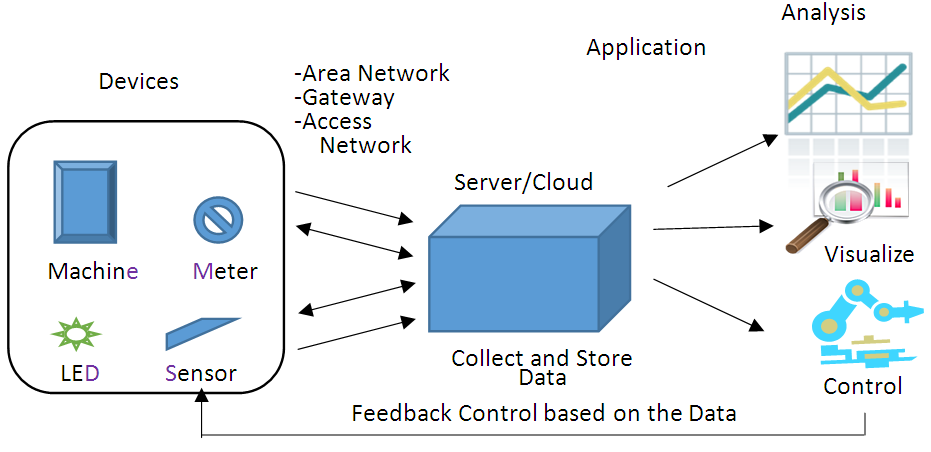 | Figure 1. IoT System overview |
3. Proposal of IoT Prototype Construction Method
- We propose a method of constructing a prototype aiming at creation of ideas for IoT application system. Using this method, the constructor produces a prototype according to the contents and procedures of a specialized field along with the basic configuration of the IoT prototype. The constructor can then understand the IoT system, create ideas, and ascertain needs for problem solving for one’s own specialized field.
3.1. Configuration and Construction of IoT System
- Figure 2 presents the basic configuration of the IoT prototype system and objectives. In the figure, the lower area shows options of the components, the middle area shows the basic configuration of IoT prototype system, and the upper area presents objectives of prototype construction. The components include open hardware, software, and cloud services. Based on this configuration, the constructor selects each component and combines them appropriately to realize the construction simply and less expensively. Configuration of the IoT prototype in the middle area in the figure is constituted such that one can experience a series of flow. A series of flow means that data are acquired from various sensors and accumulated in the server/cloud via gateway. The data are then fed back and output to actuators. Application of the gateway performs communication with IoT devices, data format conversion, and internet communication processing with the server/cloud. Because the data go through the gateway, communication tools with the server/cloud are unnecessary for every IoT device. Processing loads of the IoT device and power consumption can therefore be reduced. Cloud services and application on the server/cloud execute processing such as accumulation, conversion, and analysis of the data. When the data are fed back to the IoT device side depending on the results of processing by server/cloud, the application of the server/cloud transmits an instruction to the IoT device via the gateway. The IoT device which received this instruction issues an instruction to the actuator.
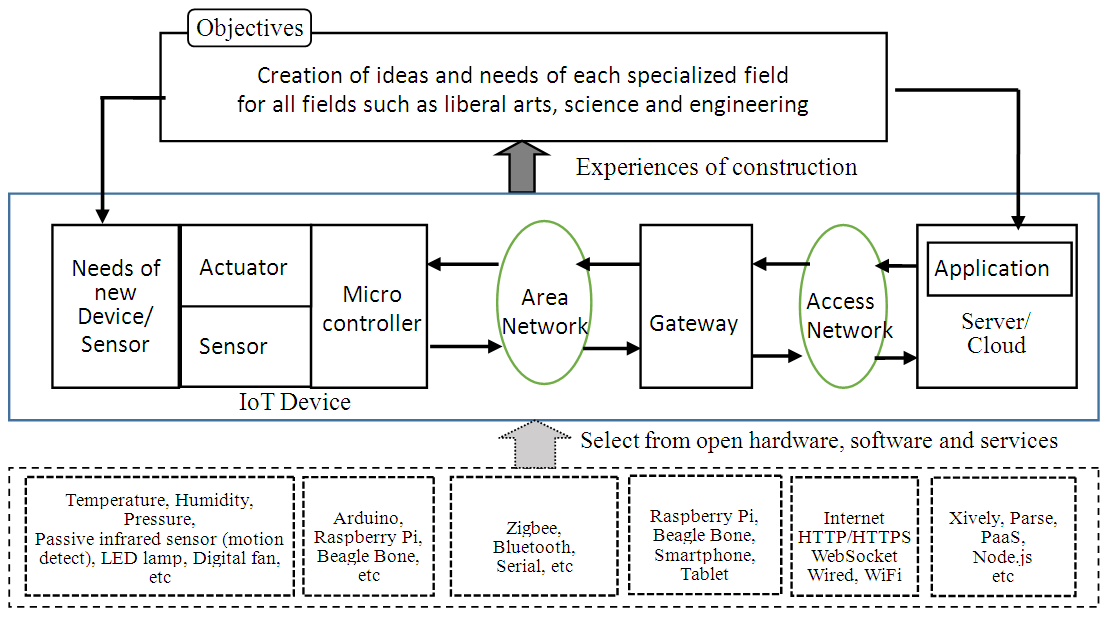 | Figure 2. Basic Configuration of IoT Prototype System and its Objectives |
3.2. Prototyping Contents for Special Fields
- Constructors were divided into two categories depending on their specialized fields. One category is science and engineering students such as electric/electronic course as well as mechanical courses. The other category is non-science /non-engineering students specialized in, for example, nursing care, childcare, welfare and housekeeping. The prototype configuration conforms to the basic configuration to elucidate the whole picture of the IoT system. Constructors are divided into two so that they can select components according to their specialized fields and so that they can perform prototyping easily.Science and engineering students such as those of electrical/electronic and mechanical courses construct a prototype using sensors and actuators related to own specialized field and use board computers as the gateway. The prototype thus constructed is practical. It can be developed easily for use in one’s own specialized field. For example, the constructor will experience prototyping to control LED brightness by illuminance to control the growth of vegetation.The objective of prototyping for non-science/ non-engineering students is comprehension of the mechanisms of the IoT system. To realize a prototype system, the constructor uses sensors and actuators that yield easy-to-understand results, with personal computers as the gateway. The constructor uses services that allow data accumulation and an easy-to-view display as the cloud service. The program is black boxed and supplied in the form of a sample program so that the constructor might not create a new program.
3.3. Construction of IoT Device Program
- The program run by the IoT device engine is operated on Arduino [8] equipped with various sensors and actuators. The program performs processing such as sensor reading, outputting to actuators and sending and receiving to and from the gateway. We define a framework as a mechanism to connect various sensors and actuators and to cope with changes of communication methods of sending and receiving to and from the gateway. The method is depicted in Figure 3. In the figure, the event table at the center is a table for control of the input–output of various sensors and actuators and timing of sending and receiving to and from the gateway according to the priority order. Each of the processes is implemented as the library and is called from the framework of event control. Even if types or combinations of sensors or actuators or types of area network differ, construction of the program is patterned. Therefore, the program can be understood easily and reused easily. Furthermore, a common class for IoT is implemented at the upper level of the sensor/actuator/ communication library shown at the center of the figure. Using this configuration, the person who created the application program can create a program with ease even if the data delivery method, types of sensor/actuator, or types of communication differ.
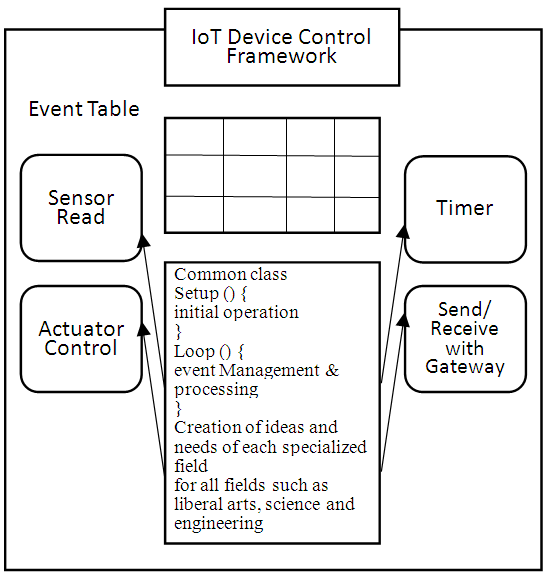 | Figure 3. IoT Device Control Framework |
4. Application of IoT Prototype Construction Method and Its Evaluations
- This chapter explains results of application of IoT prototype construction method and its evaluations.
4.1. Application and Evaluations
- We defined prototype configuration of two types by the specialized field shown in Chapter 3, prepared specifications and procedure manual and created a program to construct the prototype. Contents of the practice and evaluations by students and teaching staff are presented here.
4.1.1. Application to Science and Engineering Students in Mechanical and Electric/Electronic Courses
- (1) Application to mechanical and electronic engineering coursesFor students of Mechanical & Electronic Engineering Department of Salesian Polytechnic [9], we gave lectures and practiced engineering skills as research. Figure 4 presents the configuration constructed, with data flow and processing of the application of concrete IoT prototype system. First, data from temperature, humidity and color sensors are sent to Raspberry Pi [10], acting as the gateway in the form of a ZigBee [11] wireless interface.
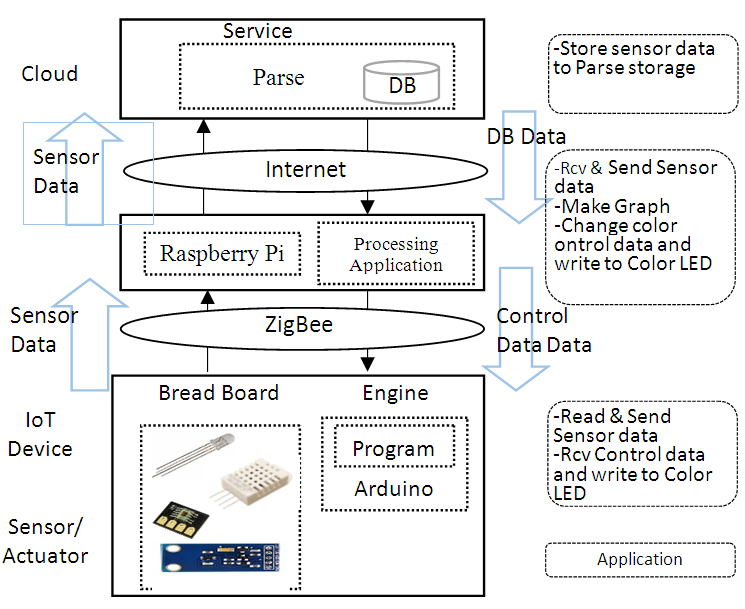 | Figure 4. IoT Prototype Example |
 | Figure 5(a). Application to hydroponic culture |
 | Figure 5(b). Graph Sample on Gateway Monitor |
4.1.2. Application to Non-science/Non-engineering Students
- At Hosen College of Childhood Education [18], where students specialize in training childcare workers in subjects such as early childhood education and childcare, we gave lectures including IoT prototyping practice. Table 1 presents a summary of the curriculum of the lectures. According to this curriculum, to perform practical training of IoT prototyping, a prototype is constructed step by step while deepening understanding by the students. Lecture contents are similar to those given to science and engineering students. One difference is that Xively [19] was used as the cloud service and PC was used as the gateway. Regarding the IoT device, Arduino microcontrollers were used to control sensors and actuators. Serial interfaces using USB were used for connection with the gateway. Figure 6 shows the configuration used. The prototype system used atmospheric pressure, temperature, and illuminance sensors and as actuators, LED lamp and electronic buzzer were used. During Steps 1–4 shown in Table 1, operations were confirmed step by step and in the subsequent “Idea Creation,” every student was encouraged to present various ideas based on the construction experience and to discuss their ideas. Non-science/non-engineering students are not familiar with programming. For that reason, the teaching staff provided programs run on Arduino and on personal computers. Figure 7 presents an example of a graphic display of sensor measurements of PC in Step 2.
|
 | Figure 6. Outcome of Manufacturing by Prototyping for Non-science/non-engineering course |
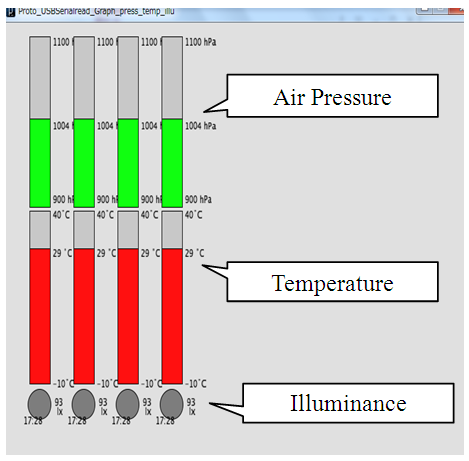 | Figure 7. Graph Display Sample of Sensor data |
4.2. Application of IoT Device Program and Framework and Evaluations
- The framework for IoT device program creation was applied to the construction of the prototype of two types. There were differences of sensors and actuators between the two types, and differences between the ZigBee connection and serial connection. Basic processing of IoT device was performed by the framework and sending/receiving to/from the gateway, and differences of type of sensors and of data sampling method among manufacturers were handled by the library. From results, it was verified that addition of new sensors and actuators is possible by a similar method. It was evaluated that, using this method, expansion of the prototype such as addition of sensors is easy and that construction of a prototype for realization of the idea is simplified.
5. Discussion
- (1) Discussion related to understanding of IoT by IoT prototype construction methodThis construction method covers IoT device fabrication, which connected sensors and actuators to gateway and cloud, and IoT system prototype construction via a network. It is characteristic that this method covers a broader range.This prototype construction method is not a mere fabrication of an electronic circuit of IoT device, but a prototype system construction method including the gateway and cloud service. Through experiences of constructing the prototype, the constructor was able to understand the IoT technology consisting of sensor technology, network technology, and information processing technology and to create ideas for the prototype application.The prototype construction method proposed here is not restricted to specialized fields. The constructor can conceive of applications from the viewpoints of how the constructor learns independently of some problem for the IoT system, and how the IoT system resolves it. Furthermore, the constructor had continually deepened understanding of how to construct an IoT system, and how to facilitate collaboration and cooperation with users of different specialized fields where necessary.(2) Discussion of idea creationOne student of the science and engineering course involved in this study was engaged in hydroponic culture using sensors and actuators related to agriculture. They were able to create an idea of remote control of the hydroponic culture easily by application of the IoT technology. With conventional hydroponic culture, colors were controlled by manual operation, but the use of IoT enabled program control and remote monitoring and control of the hydroponic culture.Although students of non-science/non-engineering courses have sufficient knowledge to manipulate personal computers and smartphones, chances for learning the IoT system are scarce. Using the prototype construction method, students constructed it step-by-step according to the procedure manual and observed data transition detected by temperature and illuminance sensors, lighting of LED lamps, and buzzer sounding. They were able to understand an outline of the IoT system in the daily life. This triggered idea creation in the field in which they were involved.
6. Summary
- We proposed a method of prototype construction for the active creation of IoT application ideas, applied it in practice, evaluated it, and discussed it. The proposal defined the basic configuration of the IoT prototype system. The contents and procedures of the prototyping of two types were specified for use for students of science and engineering courses such as mechanical, electrical/electronic courses, and students of non-science/non-engineering course specialized in different fields. By applying this prototype system construction method, the constructor deepened understanding of IoT and became able to create various ideas incorporating systematic modes of thinking and IoT application.Furthermore, this paper proposed a framework for IoT device construction and stated an IoT device construction method using this framework. Now, the constructor can connect various sensors and actuators with ease. Prototype construction of ideas using sensors and actuators has been simplified.
 Abstract
Abstract Reference
Reference Full-Text PDF
Full-Text PDF Full-text HTML
Full-text HTML